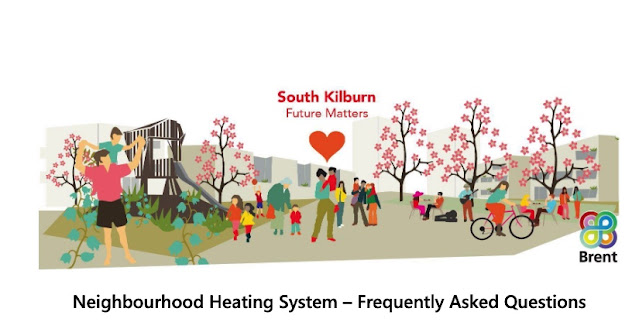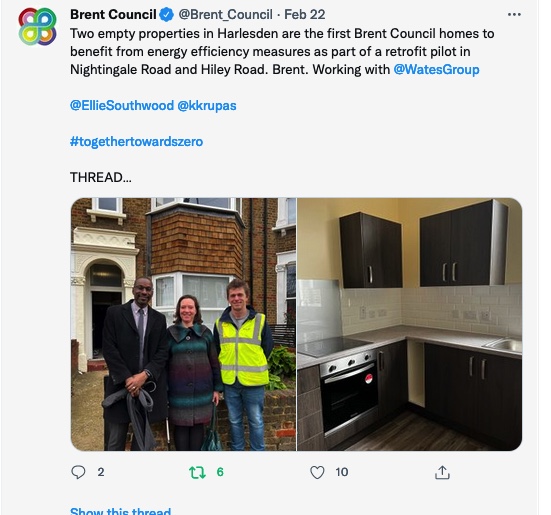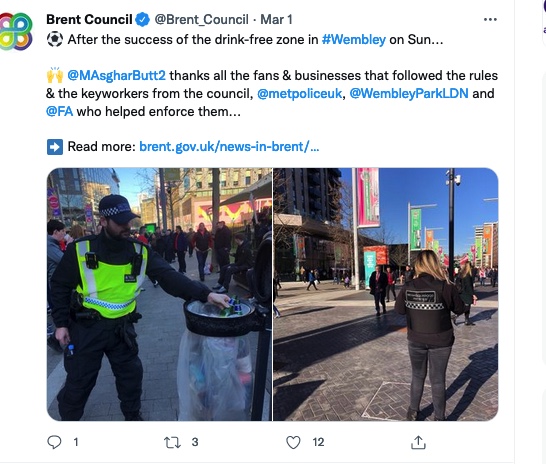Guest Blog (by Philip Grant in a personal capacity)
I watched the Live Stream recording of Brent’s Cabinet Meeting on 7 February 2022, as I have an interest in housing matters, and wanted to see how the petition from residents about the Council’s “infill” plans at Kilburn Square was dealt with. Martin published a “blog” about this, and underneath it you can see in the comments that I sent a follow-up email to the Leader of the Council.
My email to Cllr. Muhammed Butt linked his attitude at that meeting, and claims that building new Council homes was his top priority, to Brent’s plans to only provide 37 affordable rented homes in the 250-home development on land that it owns at Cecil Avenue in Wembley. Cllr. Butt replied, and his full response was included in my “guest blog” on 9 February.
At the end of his email to me, Cllr. Butt wrote: ‘I look forward to hearing that you will be watching the next Cabinet meeting; it is a fantastic thing to see more people actively involved with local democracy.’ But how much “local democracy” do we really receive through these Cabinet meetings?
Margaret, on behalf of the Kilburn Village Residents’ Association, was allowed to speak to the Cabinet. This was one of the democratic “improvements” which Cllr. Butt introduced after his Labour landslide win in the May 2014 local elections. He told our local newspaper soon afterwards: ‘New proposals allow the public to speak in council meetings for the first time ever is aimed at bettering how the community engages with the council and allows residents to hold us to account.’
But how much difference did what she said to them make? How much difference could it have made? I’m afraid that evidence I’ve recently received, under a Freedom of Information Act request, suggests that the decisions supposedly made at public meetings of Brent’s Cabinet, which people can watch and even participate in, have already been made beforehand, at meetings between Cabinet members and Senior Officers behind closed doors.
Regular readers will know that I have been trying to understand the justification for Cabinet’s decision on 16 August 2021 to allow a private developer to profit from the sale of 152 of the 250 homes on Brent’s Cecil Avenue housing scheme. This is the main site in the Council’s Wembley Housing Zone (“WHZ”). It was difficult to discover the reasoning, partly because most of the supporting documents were “exempt” (= secret), and partly because Cabinet members (and their Officers) were reluctant to provide explanations.
Extract from the WHZ report to Cabinet on 16 August 2021.
The statement that ‘Cabinet Members were consulted in July 2020’ was the subject of my latest FoI request, because there was nothing about that in the minutes of the Cabinet Meeting held on 20 July 2020!
I asked for details and supporting evidence about that “consultation”, and the results were a surprise (to me at least). These showed that, as well as the formal public meetings of Cabinet, for which we can see the agenda and reports and watch a broadcast, there are at least two other types of regular meetings of Cabinet Members and Senior Council Officers, to which we are not invited.
Heading from the WHZ Report to the internal Policy Co-ordination Group meeting in July 2020.
The “consultation” which the 16 August 2021 Cabinet Report referred to actually happened four days before the 20 July 2020 Cabinet Meeting, at a meeting of the Policy Co-ordination Group (“PCG”), a body that I had never heard of before. In many ways, it appears to be very like a Cabinet Meeting, except that the public are not made aware of it, and are not invited! This is the “preferred delivery option” paragraph from the WHZ Report to that meeting:-
From this, it appears that the “preferred option”, to involve a private developer who would sell half the WHZ scheme homes for profit, had been on the cards since at least December 2019! It is not only the Report that looks very like one prepared for a Cabinet Meeting. The written record of this meeting, though described as ‘PCG Meeting Action Points’, looks very like the minutes of a Cabinet Meeting. I received this document in response to my FoI request, although Council Officers treated it as an Environmental Information Request, which allowed them to redact one paragraph in it.
Extract from “minutes” of the Policy Co-ordination Group meeting on 16 July 2020.
I understand, and accept, that there does need to be some co-ordination of policies across the different service areas of Brent Council, but does this really need a quasi-Cabinet Meeting to achieve that result?
My FoI request had asked for details and evidence of any other discussions of the “preferred delivery option” between July 2020 and the official decision on this at the Cabinet Meeting on 16 August 2021. The response to that produced evidence of another type of internal “Cabinet Meeting”, referred to as a Leader’s Briefing, held on 26 July 2021. This “briefing” appears to be effectively a trial run-through for the Cabinet Meeting, but held three weeks before the public meeting!
As well as all members of the Cabinet, the FoI response gave details of the Senior Officers attending:
‘16 Council Officers were invited to attend the briefing, positions below :
Chief Executive; Head of Executive & Member Services; Strategic Director Children & Young People; Personal Assistant to the Leader of the Council; Director of Finance; Head of Communications, Conference & Events; Strategic Director Community Wellbeing; Strategic Director Customer & Digital Services; Director Legal, HR, Audit & Investigation; Assistant Chief Executive; Governance Manager; Strategic Director Regeneration & Environment; Scrutiny Officer; Head of the Chief Executive Officer; Senior Administrator; Operational Director Regeneration, Growth & Employment; Head of Regeneration.’
It is interesting that the Head of Communications attends these Leader’s Briefing meetings. Could that be so that he can prepare the publicity for the Cabinet decisions, in advance of them officially being made?
The “minutes” of the Leader’s Briefing meeting on 26 July 2021 are in the form of an email from a Governance Officer, and I will ask Martin to attach a copy of that document at the end of this article, should you wish to read them. You will note that there may, or may not, be amendments to the Reports which Cabinet members have received for the briefing, before they appear along with the agenda for the official Cabinet Meeting on 16 August. There was also mention of another PCG meeting, scheduled for September 2021.
The reports that went to the Leader’s Briefing meeting were marked “Restricted”. This may be because they might be changed, or because they should not be “leaked”, which would reveal that Cabinet members had already considered them before the official meeting. There was actually a slight change in the wording of the “preferred delivery option” paragraph 3.5.1 between the two dates.
In the 26 July report (below), members had ‘endorsed’ Delivery Option 2 a year before. In the 16 August report (see third image above), they had ‘indicated a preference’ for it. This may only seem a small difference, but it gives the suggestion, in the first publicly available document, that no final decision had been reached before Cabinet officially considered the matter in August 2021.
Extract
from the draft WHZ Report to the Leader’s Briefing on 26 July 2021.
What happened when Cabinet did consider the WHZ publicly on 16 August 2021 (having previously considered it in private several times since December 2019)? There were problems with the Live Streaming of that meeting, and the recording is only available towards the end of the WHZ item.
We hear Cllr. McLennan speaking about the ‘really, really good news’ that WHZ includes a number of larger homes for families in housing need, and that ‘many of them will be affordable’. Cllr. Butt then starts by saying ‘this is actually great news’, and goes on for over a minute, commending how well the Council is doing with its housing programme, and delivering homes for people who need them on its waiting list.
The Council Leader speaking about WHZ at the 16 August 2021 Cabinet Meeting.
The Leader of the Council was actually talking about a Brent housing scheme, on Council-owned land at Cecil Avenue, where 152 of the 250 homes would be sold for profit by a private developer, 61 of the so-called “affordable” homes would be for shared ownership or Intermediate Rent, and only 37 would be available for rent to local people in housing need at London Affordable Rent level! On the other WHZ site, across the High Road, although the 54 flats would be for London Affordable Rent, only 8 of them would be family-sized.
To me, that performance was just misleading “grandstanding” – playing to the public gallery over a decision that had been made in advance of the formal Cabinet Meeting, and which he hoped no member of the public had actually read the detail of the Report (and could not read any of the details in the “exempt” Appendices to it).
I asked in the title ‘are Cabinet Meetings a charade?’ You may know “Charades” as a game involving guessing words from acted clues. I think that Brent’s Cabinet are playing a game with the borough’s residents. They are acting at their meetings as if they have considered and decided the Reports attached to their agenda, after hearing what any members of the public or backbench councillors have to say at the Cabinet Meeting.
A charade (singular) is defined by the Oxford English Dictionary as ‘an absurd pretence’. If the items on the Cabinet’s agenda have been considered and decided in advance, at a Policy Co-ordination Group meeting or Leader’s Briefing, then Cabinet Meetings are a charade.
Philip Grant.






















